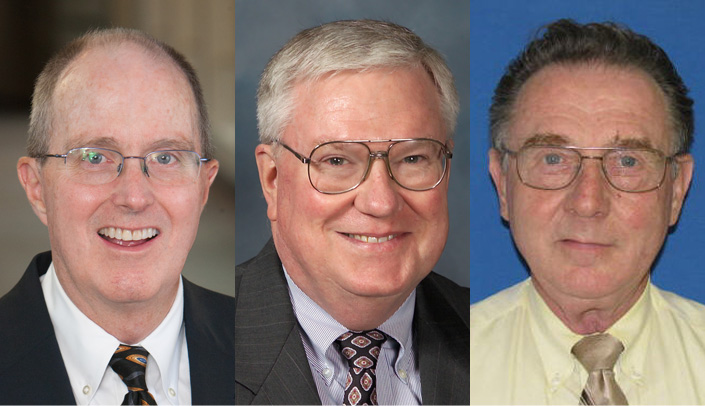By Chandra Are, M.B.B.S., vice chair, education – College of Medicine; associate professor, surgical oncology; program director, general surgery residency (Note: This story was written by Dr. Are six months ago.)
The past few months could have been passed along as any other May-June of any other year. Everyone is working hard as the arrival of summer, autumn and winter beckon the transition from one academic year to another.
The machine of change is chugging along unprecedented in its scope, magnitude or pace. The hectic pace of change traps us all in undiminished frenzy that prevents anyone from taking a pause. Taking a pause to stop and reflect on some of the events that have transpired over the past few months is essential to keep up with the pace of change and brace for the future.
I call that reflective pause: the triumvirate of 29-34-39 – the number of years, respectively, that Drs. Jim Stageman, Jim Chapin and Gordon Todd worked at the medical center before retiring, all of them within the past few months.
Twenty-nine years ago when Dr. Stageman returned from the Navy to seek a job, the medical center was a different place. Barely in its infancy, the specialty of family medicine was planting roots in many parts of the country.
One firm root was planted at the medical center, thanks in some part to the efforts of Dr. Stageman. He was instrumental in guiding the nascent family medicine residency program which is now one of the best in the nation. Amongst others, his efforts were also responsible for cementing the status of the family medicine department as one of the best in the nation. His subsequent work at the Graduate Medical Educational Committee (GMEC) was responsible for several commendations that we received from the ACGME.
Thirty-four years ago, the field of liver transplantation was in its infancy with very few centers possessing the expertise to perform liver transplant procedures. The medical center was not one of them – until the arrival of Dr. Byers W. Shaw.
Dr. Shaw brought with him a set of surgical skills that even his mentor and the father of liver transplantation marveled at. Although the surgical skill set was assured, what was lacking was the anesthesia expertise and comfort level to put these deathly ill patients to sleep. That is when Dr. Chapin with a few others travelled to Pittsburgh, the mecca of transplantation, to learn the skill set required to administer anesthesia to these sick patients.
Dr. Chapin’s efforts along with others transformed the medical center into one of the best and leading transplant centers in the world and put our name on the map of the world. Over the subsequent years he played many significant roles in the department of anesthesiology, which is now a vibrant department in the Midwest.
Thirty-nine years ago anatomy was taught in a very different environment. There was no sophisticated audio-visual equipment or state-of-the-art digital renderings of human anatomical parts. Anatomy was taught with bare hands and a few instruments in dark halls by a few that toiled beyond what was expected of them.
Dr. Todd (along with Dr. Robert Binhammer) is one of them who toiled hard to teach anatomy over the past four decades. He developed curricula that have been taught over the last several decades. His subsequent efforts as a teacher in various avenues has contributed to the department of anatomy being rated as one of the best in the nation
Although these three come from different fields, they have a few things in common:
- They all toiled beyond what was expected of them.
- They did not seek overnight fame or recognition.
- They did not do it for seeking awards.
- They worked silently in the background and let their work speak for itself.
- They worked in departments and divisions where the future may have been uncertain but they still did and gave their best.
- They had the grace and humility to accept it as a privilege to work at the medical center.
- Finally, their efforts were in some parts responsible for pushing their respective departments and divisions to become one of the best in the nation.
There are many lessons to learn from the old guard as it steps down to make way for the new guard. The most important one being that we stop, take a pause and appreciate/recognize the efforts of these individuals that are responsible for the amazing place we work in today.
The hectic pace of change, its magnitude and scope can be disconcerting to even the most open-minded employees at times. Taking a pause to realize the fine work done by such good individuals such as Drs. Stagemen, Chapin and Todd reassures us that our future is safe. They started their careers as well during times of significant change such as now and thrived.
There are other employees such as these three that have worked hard in the past, embraced change and thrived. There are indeed many others that are now working hard and silently in the background, just like them.
In times such as now when change is omnipresent and omnipotent, the thought of the likes of Drs. Stageman, Chapin and Todd working silently in the background is enough to reassure us that the future of the University of Nebraska Medical Center and Nebraska Medicine is bright, strong and secure.
